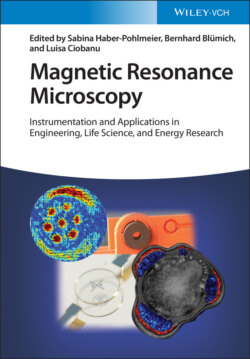Читать книгу Magnetic Resonance Microscopy - Группа авторов - Страница 49
3.3 Three Levels of POC Use
ОглавлениеWe arbitrarily divide POC MRI use cases into three levels based on their deviation from a conventional high-field scanner suite. The closest level employs modest deviations from a standard 1.5-T scanner approach and attempts to improve siting (and perhaps cost) to facilitate siting within a tight ED or ICU space. This “easy-to-site suite” scanner could utilize a standard superconducting solenoid magnet architecture, perhaps at reduced field strength, but with modifications to decrease its cost, size, and stray-field footprint. For example, the system might use a short-bore, conduction-cooled superconducting magnet to eliminate cryogens and the quench-pipe. The footprint, size, and cost can be reduced compared with conventional whole-body scanners if the magnet is sized for brain imaging and operated at mid-field (between 0.5 T and 1.0 T). This intermediate field strength can provide sensitivity and imaging contrasts similar to conventional 1.5-T scanners while increasing accessibility – a topic recently reviewed and put into historical perspective [28]. Addition of active electromagnetic interference (EMI) mitigation could further ease siting by eliminating the standard radiofrequency shielded room. Although the system retains many aspects of conventional suites including high-power electrical hookups (for conventional gradients), maintenance-prone cryogenic equipment, water cooling, and a safety exclusion zone, the potential siting benefits have motivated several commercial MRI manufacturers to initiate development of this type of device (see Figure 3.1).
Figure 3.1 Superconducting MRI systems recently introduced to the market to provide high-quality imaging with reduced siting needs. All employ conduction-cooled magnets to eliminate the need for “quench pipes” to vent cryogenic gases. From left to right: GE (Waukesha WI) 3-T “compact head scanner,” the Synaptive Medical (Toronto, ON, Canada) 0.5-T “Envry” compact scanner, and the Siemens Healthineers (Erlangen, Germany) 0.55-T “Free Max” compact 80-cm diameter patient-bore scanner (Siemens Healthcare GmbH).
The second level would be a truly portable scanner that could be pushed down the hallways of the hospital by a single staff member who brings it into the ward or even to the bedside and powers it up for POC use. This device must operate using a standard electrical outlet or perhaps battery power, the latter allowing it to be embedded in an ambulance or mobile setting. The mobile POC scanner would likely operate at low field (50–200 mT), need unconventional EMI mitigation, and must operate with substantially reduced electrical power compared with conventional systems and without water cooling or cryogenics. This class of POC devices is being actively pursued by several companies and academic groups as discussed in Section 3.3.2.
Finally, the third class is a more speculative device that extends MRI to a near “handheld” level, likely with a greatly reduced imaging capabilities, but inexpensive and small enough to be considered an MR detector or monitoring device more than a diagnostic imaging device. Such a lightweight device could reach into the bed and monitor an organ, perhaps using 1D imaging or just the MR signal itself. This rethinks the role of MRI as a tomographic imager and, as such, is the most distant from conventional MRI scanner architectures. Nonetheless, examples of this more speculative device are starting to emerge in the literature as outlined in Section 3.3.3.
